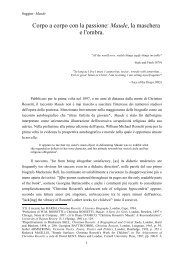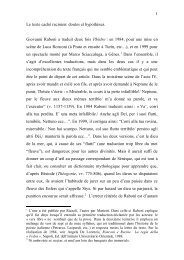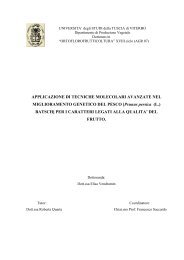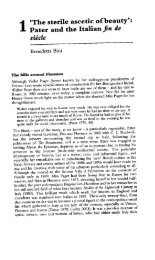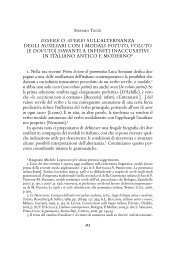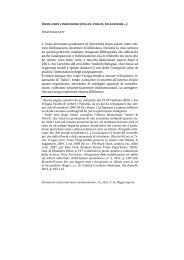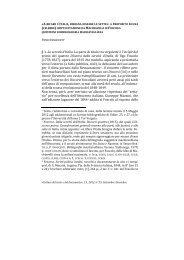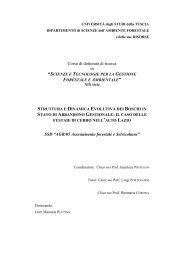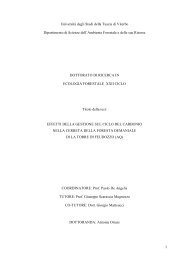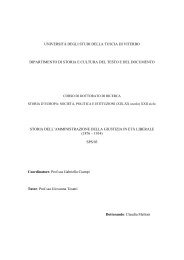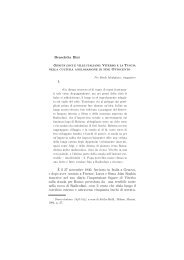drivers of soil respiration of root and microbial ... - Unitus DSpace
drivers of soil respiration of root and microbial ... - Unitus DSpace
drivers of soil respiration of root and microbial ... - Unitus DSpace
You also want an ePaper? Increase the reach of your titles
YUMPU automatically turns print PDFs into web optimized ePapers that Google loves.
3.4. Discussion<br />
3.4.1. Speed <strong>of</strong> C cycling<br />
82<br />
New C cycled quickly within the ecosystem, with a great proportion <strong>of</strong> recently assimilated<br />
C respired within the first day (Fig.7). The first peak in evolution <strong>of</strong> 13 CO2 occurred less than one<br />
hour after the opening <strong>of</strong> the LC, both in above <strong>and</strong> belowground <strong>respiration</strong>, followed by the other<br />
peaks in the course <strong>of</strong> the day (Fig.5). These initially high values in the 13 C signature <strong>of</strong> respired<br />
CO2 is possibly attributed to the residuals <strong>of</strong> the label which may have diffused to the <strong>soil</strong> pores<br />
during the pulse labeling procedure <strong>and</strong> consequently is not <strong>of</strong> a plant-origin. In fact some studies,<br />
confirm this phenomenon for the in situ pulse labeling experiments (Ostle et al., 2003, Leake et al.,<br />
2006). Ostle et al. (2003) by increasing the number <strong>of</strong> the replicates (from 3 to 6) <strong>and</strong> the sampling<br />
frequency improved the results reported by Staddon et al. (2003). The greater replication gave more<br />
consistent results with peak 13 C enrichment <strong>of</strong> <strong>soil</strong> <strong>respiration</strong> occurring 1 day after the labeling,<br />
rather than 2 hours, reported by Staddon et al. (2003). In fact, laboratory conditions permit to isolate<br />
the <strong>soil</strong> compartment during the labeling procedure, avoiding the uncontrollable penetration <strong>of</strong> the<br />
label into the <strong>soil</strong>, while in situ its quite impossible. The 13 C signature <strong>of</strong> the aboveground<br />
<strong>respiration</strong> experienced a small decrease during the first hour after the pulse labeling, but the first<br />
peak originating from plant <strong>respiration</strong> occurred between 2 <strong>and</strong> 4 hour <strong>of</strong> the chase period (Fig.3b).<br />
This time lag is similar to the one reported by Carbone <strong>and</strong> Trumbore (2007) for the grassl<strong>and</strong>s <strong>and</strong><br />
shrubl<strong>and</strong>s, where the 13 C in aboveground <strong>respiration</strong> peaked in the first 4 hours after the pulse<br />
labeling.<br />
The 13 C fixed by shoots may be respired, used in production <strong>of</strong> new shoot growth,<br />
temporarily stored (e.g. in starch), or allocated belowground into <strong>root</strong>s <strong>and</strong> from them to <strong>soil</strong><br />
organisms <strong>and</strong> belowground <strong>respiration</strong> (Leake et al., 2006). In belowground <strong>respiration</strong> there was<br />
observed again initially high value <strong>of</strong> the 13 C content. However, we argue that the translocation <strong>of</strong> C<br />
from leaves to <strong>root</strong>s <strong>and</strong> into <strong>soil</strong> <strong>respiration</strong> occurred later, in the time the next peak in<br />
belowground 13 CO2 <strong>respiration</strong> was registrated (Fig. 3c). This peak occurred from 16 to 24 hours<br />
after the pulse labeling. The same peak was observed also in aboveground <strong>respiration</strong>, which<br />
indicates that we were not able to separate completely above <strong>and</strong> belowground <strong>respiration</strong> by<br />
subtracting from total <strong>respiration</strong> the CO2 evolved from the bare plots. Another possible<br />
explanation could be the re-fixation in shoots <strong>of</strong> the 13 C respired from the <strong>soil</strong> or back flow <strong>of</strong> the<br />
pulse C from belowground, as was observed by Johnson et al. (2002), e.g. from 13 C sugar that<br />
passed to the <strong>root</strong>s being combined with ammonium, taken previously up from the <strong>soil</strong>, to form 13 C-<br />
enriched amino acids that are then transferred back to the shoots.<br />
Carbone <strong>and</strong> Trumbore (2007) for a grassl<strong>and</strong> site reported the time lag <strong>of</strong> less than 4 hours<br />
for the belowground grassl<strong>and</strong> <strong>respiration</strong>, but the number <strong>of</strong> sampling times in their study was less




